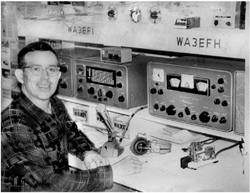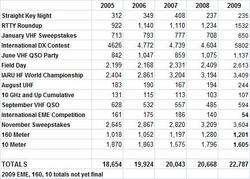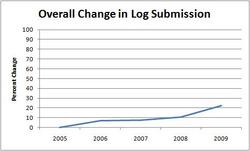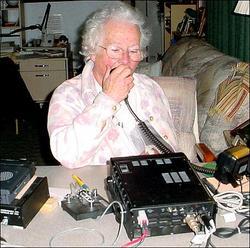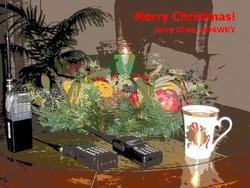 December 23, 2009 Editor: Ward Silver, NØAX | ||||||||
IN THIS ISSUE
NEW HF OPERATORS - THINGS TO DO If you are hesitant to try your CW skills during a full-blown contest, how about a relaxed evening of straight key brass pounding? Before you head out for the night's jollity, fire up the rig and try a slow-speed CW QSO in the ARRL's annual Straight Key Night. BULLETINS I've received a few submissions for the Creative Compendium issue - keep those pencils sharp and to the point! See the 9 Dec issue for complete details! BUSTED QSOS In last week's item on ham radio license totals, the graph by WBØOEW was based on data from AH0A.org, not from the data in the eham.net article. CONTEST SUMMARY Complete information for all contests follows the Conversation section Dec 26-27
Jan 1
Jan 2-3
NEWS, PRESS RELEASES, AND GENERAL INTEREST
The ARRL has just published a new book on antennas by Brian Cake KF2YN, called "The ARRL Antenna Designer's Notebook -- An Exploration of the Art of Antenna Design". Your editor had the privilege of working as Brian's editor - I found the book fascinating not only because of interesting new designs, but because the whole story of development is presented, not just the final product. There are designs for HF as well as VHF+ opeation. An EZNEC model is presented for every antenna in the book on a companion CD, giving complete dimensions for the builder. Enjoy! Don't forget Kid's Day is coming on 3 Jan! If you want an extra challenge, why not try to make a satellite QSO? AMSAT-NA and the AO-51 Operations Group will have AO-51 configured with the straightforward FM voice 145.880 MHz uplink and 435.300 MHz downlink. Remember that the passes are short, but wouldn't a QSO though a "bird" be a memorable experience? AO-51 will also be available during Straight Key Night using 145.880 MHz USB for the uplink and 435.150 MHz FM for the downlink. While Saturday was a dull day in the ARRL's 10 Meter contest, Sunday was the opposite for many. Larry N7DF seems to have found an answer. "The surprising propagation that occurred on Sunday afternoon appears to have been the result of a major shift in the interplanetary magnetic field. All day Saturday the Earth-Sun flux path (Bz) was positive or north-oriented but it shifted about 0300Z allowing the solar wind to penetrate the northern hemisphere until about 2000Z when it began to "ring" creating sporadic bursts of high energy areas in the ionosphere. This was evidenced by the "spotlight" opening that many enjoyed with good runs into limited areas. This was one of the most clear-cut cause-and-effect examples I have ever seen. It probably would not have been evident if it had not been for all the contest activity." His closing point is especially good - if we just tune through the band and don't call CQ, we'll never know if something interesting is happening! "Early bird" registration is now open for the 4th Dayton ConTest University ("CTU") 2010. This will be the only Contest University held in the USA during 2010. CTU USA will be held in Dayton, Ohio on Thursday May 13, 2010 (classes last all day), just before the Dayton Hamvention. CTU is supported by flagship sponsor Icom America, as well as CQ Magazine, DX Engineering, Superbertha, International Radio, and Dave, W9ZRX. Based upon the tremendous attendance at Dayton CTU 2009, 2010 student registration slots are expected to fill up fast and space is limited. CTU will be held in the United Kingdom and Italy again in 2010. Watch for future announcements of additional European CTU locations. Thanks to Scott, KA9FOX and QTH.com for his hosting of the Contest University Web site! (Thanks, CTU Chairman Tim K3LR) Guy N7ZG has made all CQ World Wide contest logs from the last three years available as CSV spreadsheet files. Guy instructs, "There are two files. The first (CQWWCW-ENTRIES.txt.zip) consists of one row per submitted log. It contains the submitter's category of entry, claimed score, location, etc. The second file (CQWWCW-CONTACTS.txt.zip) contains the QSO data (10 million plus rows)." Trippy AC8EP writes about CQ100 Internet-based contest simulations. The next contest runs from 2300Z Jan 1 to 2300Z Jan 3 on the software's 80 through 10 meter bands, both voice and CW. CQ100's W/VE contest will run on Jan 29 - 31.
The life of a maritime radio officer sounds pretty good - lots of operating, spare time, fresh air - until you read a story like "A Ham Without a Country" on the ARRL Web site. I'm sure that one had a few of the old salts nodding in recognition! Web Site of the Week - You may have used the Vaisala Lightning Detection Network, but there is a new service online. David K1TTT recommends the new World Wide Lightning Location Network with automatic updates every 10 minutes and data viewed via Google Earth. (Thanks, Randy K5ZD) WORD TO THE WISE Soapbox - comments about the contest sent along with the log for the contest sponsors to read and publish. The ARRL has an online Soapbox page that can accept not only your stories, but your photos, too! Writeup authors often look through your comments and photos to get ideas and interesting stories for the results articles. If you report your Claimed Score via the 3830 Web site, you can also contribute soapbox comments there. If you choose to add comments to your Cabrillo-formatted log, use the SOAPBOX: tag - there is no limit on how much you can say. For some good reading, check out VK8AA's entry for the just-finished ARRL 10 Meter contest! SIGHTS AND SOUNDS You may have seen the RRTC-2009 video taken at this summer's Russian Radiosport Team Championship, but if you don't speak Russian, it's been subtitled in English. Thanks to Alex RX3AEX, Roger G3SXW and Nodir EY8MM for their efforts and translation! (Thanks, WRTC-2010 Committee, Harry RA3AUU) The next time you are working on the tower, fully clipped in and lanyarded, think of these fellows putting on a high-wire act on the high-tension lines and towers! (Thanks, David K1TTT) Wow - this Web site has quite a collection of images of old radios and tubes! You can spend hours at Jim Tripp's Antique Radio Museum looking for that "special" radio! The tube photos are particularly interesting. (Thanks, Tim W7TRH) I saw a bit of these videos on a recent newscast and I know my readers will find them fascinating. The University of Nottingham has produced a series called "The Periodic Table of Videos" with a feature on each and every one. Yes, there are explosions and vapors and fumes, but it's great education, too! 2009 Contest Wrap-Up by Sean KX9X, ARRL Contest Branch Manager
Wow, what a great year this has been for Radiosport here at the ARRL! Going with the premise that "more is better," we should all be quite happy with the numbers. Participation in ARRL events - and Radiosport in general - has been trending upward for over three years now. As Warner Wolf used to say, "Let's go to the videotape!" In this case, the spreadsheet: With a 36% increase in participation in the November Sweepstakes, 66% increase in the RTTY Roundup and a 25% increase in the ARRL DX contest over the last five years, the increase in interest is nothing short of phenomenal, especially when you factor in the prolonged lack of sunspots!
I still see those numbers slipping in the VHF+ events, except for the June VHF QSO Party when 6 meters generally rules the roost. The August UHF Contest received an infusion of life, thanks to the inclusion of Club Competition in the event. I'll keep saying it: if you're not trying VHF+ contesting, you're missing out on some serious fun. Contesting continues to be educational, practical and fun for all levels of competitor. It also is one of the finest and open communities of people I've ever encountered. As a whole we share our knowledge and skills with both the newcomer and even our competitors in an effort to make our sport as rewarding as it can possibly be for all involved. How many other communities can say that?
What will 2010 bring from the Contest Branch? Hopefully some sunspots, but we've got some things up our sleeves, so stay tuned for a couple of interesting developments. Thanks for your participation in ARRL contests; I'll see you on the bands in 2010. If you ever have a question or problem, call or email me anytime and I'll take care of it as best I can. RESULTS AND RECORDS The referees will be in the replay booth a long time to sort this out: the claimed scores in the ARRL 160 Meter contest for W2GD and KC1XX are an identical 645,270 points! Thanks to the troupe of volunteer typists that hand-entered 17,693 QSOs from 118 paper logs submitted for the ARRL Sweepstakes. The most prolific was Larry K5OT's 34 logs with 6741 QSOs. No, he doesn't get to count any of them toward his score next year, but we do owe the whole team a round of applause. Please help your club members submit electronic logs and put these folks out of business! Preliminary results for the 2009 Illinois QSO Party are available for viewing. Danny NG9R notes that the quick turnaround was almost a one man effort. Jim N9JF, reported that being home with the flu let him find the time to do the log checking in such a timely fashion. The results from the October PreStew warmup contest have been posted. The real Stew Perry Top Band Distance challenge is this coming weekend. Contest Manager Tree N6TR notes that conditions on 160 meters have been very good all month and hopes you can join the fun. How good have conditions been on 160 meters, lately? Many stations are reported to have worked WAS the first night of the ARRL 160 Meter Contest this year. If you have exceptional stories or photos, the contest's results author, Gary K9AY, would like to hear from you at k9ay@k9ay.com. Yuri K3BU has updated his compilation of CQ World Wide 160 Meter Contest records for both CW and SSB. The new Assisted category has resulted in an "avalanche" of new records. Multi-operator call sign lists are not available. He is also tracking WAS and DXCC accomplishments during a single contest. OPERATING TIP Here's a motivational idea that's particularly good for teams - make a chart showing the previous year's score for the contest, hour by hour, and post it where it can be seen from the operating position. Update the team's progress every hour with the goal to keep the new line above the old line! TECHNICAL TOPICS AND INFORMATION If you are the recipient of a new computer, you are probably still looking for the RS-232 serial ports! Never fear, Rick WW3DE has used Prolific and Belden serial to USB adapters without problems for RTTY and rig control. Don Hill, AA5AU, has information about this on his excellent RTTY contesting Web site. Safety first - before starting work on that amplifier, make SURE that all high-voltages are completely discharged. The usual technique is to use an insulated grounding stick to short all HV points to ground. The 2010 ARRL Handbook has a design for one you can make yourself. Commercial sources include Salisbury and Ross Engineering. (Thanks, John K5PRO) Ian GM3SEK posted a link to a Web site with lots of information on capacitor testing, replacement, and selection. If you repair equipment or rebuild older radios, this might be a good Web site to bookmark. Consumer electronics connectors may be all around us, but finding one or two for a project can be a problem. In addition, their small size makes a chore out of soldering to them - if you can find a solderable version. Roger K8RI reminds us that it may be a better and cheaper idea to find the connector you need already attached to a mass-produced cable. Cut the cable in half and you have two cables. A bit of work with an ohmmeter to correlate pins and wires and you're ready to go. If you can find those connectors, keep them plugged into a mating connector when soldering to act as a heat sink and keep those tiny pins aligned in the plastic body. (Thanks also, Mike K6BR)
Mike W5EGO has found breakout boxes to be a handy test bench aid for multi-conductor cables and connectors. Wire each connector to a separate BNC, RCA, or banana jack - even a terminal strip will do. This gives you instant access to each signal without a jumble of bare wires. Reading a lot of email reflectors as I do, I note that new appliances with motors and/or speed controllers are a frequent source of EMI. One pro-active strategy is to notify the salesman and write on the sales invoice that if the appliance causes interference, you will return it. This may or may not give you some leverage if you get a noisy model. Once the appliance is installed, if it's found to cause interference, the company may have a service bulletin on the subject. Repairs could be covered under a warranty if you report them promptly. If the changes don't completely suppress the noise, the directions may point out noise sources that might respond to additional ferrite cores (the newer type 61 mix works well at HF). Building an antenna library? Want to know the Real Deal behind all the variations of design? Here are a few classic titles from the QRP email reflector's conversation on the subject. Most are available used or can be borrowed from the library: Lee K7TJR has published his design for a three-element, shortened vertical receiving array for 160 meters. It uses high-impedance amplifiers for each element and can work in a small triangle of 40 feet per side. Here's an assignment for those curious about log periodic -or "log" - antennas. Browse to the ARRL home page and log in. Then use the QST Archive Search tool to find "Practical High Performance HF Log Periodic Antennas" by Bill Jones K8CU in the September 2002 issue. Tasty! (Thanks, Dino KX6D) If you saw the sides off a log, does that make it a beam? That's a joke from timber country... Here's a tool name I didn't know - Spudger -- a general-purpose wiring/electronics tool, basically a nylon or wooden stick, frequently with a hook on one end, used for grabbing wires, prying parts or plastic cases open, setting DIP switches, and other common electronics and telecom functions. (from Make: December 2009 newsletter) Technical Web Site of the Week - A recent webinar hosted by Microwave Journal may be of interest to Contest Update readers. "RF Board Design - Understanding Radiation and Coupling" covers topics such as: CONVERSATION Oh, Spirit! You may have missed this small item in ARRL Propagation Bulletin ARLP052: The NOAA solar indices tracking data shows how many millionths of the visible solar hemisphere are occupied by sunspots. As long as the trend under "Sunspot Area 10E-6 Hemis" keeps rising, so does the MUF. As of Monday, 20 Dec, we've had at least one spot on the solar disk for nearly two straight weeks! O frabjous day! What a great holiday present this is! I'm sure some wag will soon concoct a story pointing out that we are now technically at the peak of Cycle 24.
Is this new sunspot enough to complete the visitations foretold to us by the ghost of old Jacob Maunderly, dragging his chain of three-and-twenty solar cycle record books behind him? As the clock strikes one, the Spirit of Cycles Past visits us first in the guise of Straight Key Night, tap-tap-tapping at a Victorian instrument Samuel Morse would recognize. The ritual greeting of RST, QTH, name, and weather swells and fades in our headphones between static crackles and heterodynes. Our vision complete, we sign with shave-and-a-haircut as the filaments fade to dull red and meter needles fall to the left-hand peg. Two sonorous chimes summon the Spirit of Technology Present, greatly advanced since even 2002's glory days of the previous cycle. Solar observation has taken great strides with a bevy of satellites on duty and new ones headed out. Terrestrially, propagation modeling just keeps getting better. We have desktop PC software for digital modes that put meteor scatter, moonbounce, and QRPPP communications within reach of any ham. Our receivers and antennas do more for us than ever before. The visiting spirit fades away into the winter night as we sit transfixed in our wondrous shacks that sport cornucopic wireless wealth and knowledge...talking about the weather. Once again tossing amongst the bedclothes, we dream of the spectral serenade's last note. What lies ahead as 15 and 12 and 10 meters slowly raise sleepy heads from their long dormancies? Primed with history and armed with technology, anticipation is more intense than ever. I know this seems improbable to some of our newer compatriots, but during "the majors" not so many years ago, stations from every Zone and continent teemed shoulder to shoulder, filling ten meters like fish in the sea. Perhaps there will be a flood of new calls from different lands - India, China, or maybe a surprise! I can only wonder - when the ionosphere starts returning those signals back to Earth, who will we hear and what will they say? As the automated receivers harvest and publish calls and frequencies from all around the globe, how will that change contesting and DXing? Will fluttery wisps of antipodal signals still echo their way along the gray line at dawn? Will the thrill of an unexpected contact still make hams jump up and raise their arms in elation and surprise? Will we still await 0000Z on Friday afternoon with the same nervous excitement? Will we talk about the weather? Listen! The clock is striking three... CONTESTS 23 December 2009 to 5 January 2010 An expanded, downloadable version of QST's Contest Corral in PDF format is available. Check the sponsor's Web site for information on operating time restrictions and other instructions. HF CONTESTS South Dakota QSO Party--Phone,CW,Digital, from Dec 26, 0000Z to Dec 26, 2400Z. Bands (MHz): 1.8-28. Frequencies: CW: 1.805, 3.550, 7.050, 14.050; Phone: 1.890, 3.890, 7.230, 14.290, 21.350, 28.400. Exchange: RS(T) and SD county or S/P/C. Logs due: Jan 28. Rules RAEM Contest--CW, from Dec 26, 0200Z to Dec 26, 0959Z. Bands (MHz): 3.5-28. Exchange: Serial and lat/long in degrees. Logs due: Jan 8. Rules DARC Christmas Contest--Phone,CW, from Dec 26, 0830Z to Dec 26, 1100Z. Bands (MHz): 3.5-7. Exchange: RS(T) and DOK or special station code. Logs due: 3 weeks. Rules Stew Perry Top Band Distance Challenge--CW, from Dec 26, 1500Z to Dec 27, 1500Z. Bands (MHz): 1.8. Exchange: Grid square. Logs due: Jan 31. Rules 070 Club QRP DX Scramble--Digital, from Dec 27, 0000Z to Dec 27, 2400Z. Bands (MHz): 14. Exchange: Call sign, first name, WR 100 entity. Logs due: Jan 28. Rules ARRL Straight-Key Night--CW, from Jan 1, 0000Z to Jan 1, 2400Z. Bands (MHz): 3.5-28, 50+. Exchange: General QSO. Logs due: Jan 31. Rules New Years Snowball Contest--Phone,CW, from Jan 1, 0000Z to Jan 1, 0100Z. Bands (MHz): 3.5. Exchange: RST, serial, AGB number. Logs due: 3 weeks. Rules SARTG New Year RTTY Contest--Digital, from Jan 1, 0800Z to Jan 1, 1100Z. Bands (MHz): 3.5-7. Exchange: RST, serial, Happy New Year in your language. Logs due: Jan 31. Rules AGCW Happy New Year Contest--CW, from Jan 1, 0900Z to Jan 1, 1200Z. Bands (MHz): 3.5-14. Exchange: RST, serial, AGCW number. Rules Original QRP Contest--CW, from Jan 2, 1500Z to Jan 3, 1500Z. Bands (MHz): 3.5-14. Exchange: RST, serial, and category. Logs due: Jan 31. Rules ARRL RTTY Roundup--Digital, from Jan 2, 1800Z to Jan 3, 2400Z. Bands (MHz): 3.5-28. Exchange: RST, state/province/serial. Logs due: Feb 2. Rules EUCW 160 Meter Contest--CW, from Jan 2, 2000Z to Jan 2, 2300Z and Jan 3, 0400Z to Jan 4, 0700Z. Bands (MHz): 1.8. Exchange: RST, serial, club name, member nr or "NR". Logs due: Feb 15. Rules Kid's Day--Phone, from Jan 3, 1800Z to Jan 3, 2400Z. Bands (MHz): 3.5-28. Exchange: Name, age, location, favorite color. Rules ARS Spartan Sprint--CW, from Jan 5, 0200Z to Jan 5, 0400Z. Bands (MHz): 3.5-28. Frequencies: Monthly on the first Monday evening. Exchange: RST, S/P/C, and power. Logs due: 2 days. Rules VHF+ CONTESTS ARRL Straight-Key Night--CW, from Jan 1, 0000Z to Jan 1, 2400Z. Bands (MHz): 3.5-28, 50+. Exchange: General QSO. Logs due: Jan 31. Rules LOG DUE DATES 23 December 2009 to 5 January 2010 December 24 - MDXA PSK DeathMatch, email log summary to: chucklem@comcast.net, paper logs and diskettes to: (none). Rules December 27 - Run for the Bacon QRP Contest, paper logs and diskettes to: (none), upload log at: http://www.fpqrp.com/autolog.php, paper logs and diskettes to: (none). Rules December 31 - Kentucky QSO Party, paper logs and diskettes to: k4cms@aol.com, paper logs and diskettes to: Western Kentucky DX Association, P.O. Box 73, Alvaton, KY 42122, USA. Rules December 31 - JIDX Phone Contest, paper logs and diskettes to: ph@jidx.org, paper logs and diskettes to: JIDX Phone Contest, c/o Five-Nine Magazine, P.O. Box 59, Kamata, Tokyo 144-8691, Japan. Rules December 31 - All Austrian 160-Meter Contest, paper logs and diskettes to: hf-contest@oevsv.at, upload log at: http://contestrobot.aoec160m.oevsv.at, paper logs and diskettes to: OEVSV-HQ, HF-Contest Manager, Eisvogelgasse 4/1, A-1060 Vienna, Austria. Rules December 31 - IPARC Contest, CW, paper logs and diskettes to: dj6qq@darc.de, paper logs and diskettes to: Uwe Greggersen, DL6QQ, Hurststr 9, D-51645 Gummersbach, Germany. Rules December 31 - IPARC Contest, SSB, paper logs and diskettes to: dj6qq@darc.de, paper logs and diskettes to: Uwe Greggersen, DJ6QQ, Hurststr 9, D-51645 Gummersbach, Germany. Rules December 31 - TOPS Activity Contest, paper logs and diskettes to: yo2rr@clicknet.ro, paper logs and diskettes to: Ioan Branga YO2RR, Str. Imparatul Traian nr.2, RO-305500 LUGOJ, ROMANIA. Rules December 31 - Mongolian DX Contest, CW/SSB, paper logs and diskettes to: jtdxcontest@gmail.com, paper logs and diskettes to: Mongolian DX Contest, CW/SSB, P.O. Box 830, Ulaanbaatar-24, Mongolia. Rules January 1 - Feld Hell Sprint, paper logs and diskettes to: (none), post log summary at: http://www.emailmeform.com/fid.php?formid=202397, paper logs and diskettes to: (none). Rules January 2 - TARA RTTY Melee, paper logs and diskettes to: (none), post log summary at: http://www.n2ty.org/seasons/tara_melee_score.html, paper logs and diskettes to: (none). Rules January 3 - ARCI Topband Sprint, paper logs and diskettes to: contest@qrparci.org, paper logs and diskettes to: ARCI Top Band Sprint, c/o Jeff Hetherington, VA3JFF, 139 Elizabeth St. W., Welland, Ontario L3C 4M3, Canada. Rules January 5 - ARRL 160-Meter Contest, paper logs and diskettes to: 160meter@arrl.org, paper logs and diskettes to: 160 Meter Contest, ARRL, 225 Main St., Newington, CT 06111, USA. Rules January 5 - ARRL EME Contest, paper logs and diskettes to: EMEcontest@arrl.org, paper logs and diskettes to: EME Contest, ARRL, 225 Main St., Newington, CT 06111, USA. Rules January 5 - ARRL EME Contest, paper logs and diskettes to: EMEcontest@arrl.org, paper logs and diskettes to: EME Contest, ARRL, 225 Main St., Newington, CT 06111, USA. Rules January 5 - ARRL EME Contest, paper logs and diskettes to: EMEcontest@arrl.org, paper logs and diskettes to: EME Contest, ARRL, 225 Main St., Newington, CT 06111, USA. Rules ACKNOWLEDGEMENTS ARRL Contest Update wishes to acknowledge information from WA7BNM's Contest Calendar and SM3CER's Contest Calendar. | ||||||||

